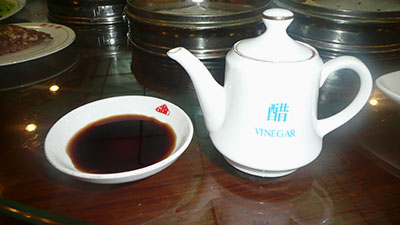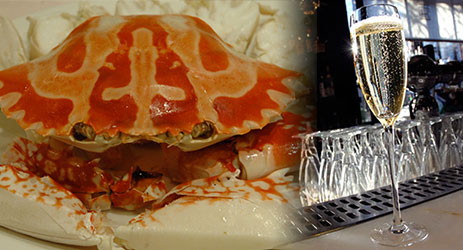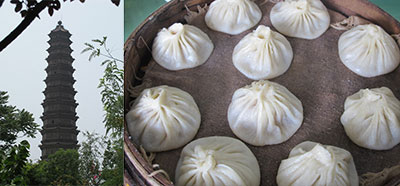CH'NG Poh Tiong's column: Zuo Wang

We all know that vinegar, particularly aged vinegar – whether Italian Balsamic vinegar or Chinese rice vinegar – aids digestion and is a wonderful accompaniment to dip into, or splash over, food that is oily and rich.
Vinegar possesses the miraculous quality in refreshing not only a heavy dish and the person eating it, it helps recharge and enhance our appetite to continue eating.
Vinegar is uplifting!
There is, however, a flip side to vinegar. The phenomenon is akin to a ‘Good Cop, Bad Cop’ situation. Do you recall how in movies a suspect is questioned alternatively by an aggressive policeman and then by another more gentle, understanding one? Well, vinegar can be something like a ‘Good Cop, Bad Cop’ at the same time.
Just as it has the quality of lifting foods and our appetite, we should also be aware that vinegar will compromise, even completely neutralise, a wine.
As such, if you have a dish that is dominated by vinegar or a Western salad dripping in it, wine will be completely wasted should you decide to pair that with the dish or salad. Depending on the strength and intensity of the vinegar the wine will be reduced to a fraction of its personality or even completely wiped out.

When I, for example, am having Chaozhou Cold Crab or Kai Feng Xiao Long Bao (around since the Song Dynasty 960-1279 and much more delicious than the ones in Shanghai), I never dip them in the white or black vinegar that are offered with those dishes respectively.
Instead, I just eat them as they are presented and pair the crab with a medium-plus to full-bodied champagne (make sure it is not too acidic otherwise the crab will taste ‘metallic’) or a Chablis of about five years old and, in the case of the Xiao Long Bao, with a four to six year old red Cotes-du-Rhone Villages or a well-made generic or non-classified petite chateau red Bordeaux.
The roundness of the Cotes-du-Rhone Villages and red Bordeaux are delicious with the pork filling and the flour wrapping of the Xiao Long Bao.
Although Cotes-du-Rhone and a generic red Bordeaux are two of the most humble AOC wines of their respective regions, we must not assume that they should be served as young as possible. This is an unfortunate and huge mistake.
Even a simple red needs some time for the fruit to evolve and for the tannins (whether from the skin or skin and oak) to resolve themselves. Otherwise, if the tannins are still tough, edgy, fiery and ‘angry’, instead of pairing with the food, they will be doing battle with it. Drinking wine with food is meant to be enjoyable experience. It should not be like starting World War III.
Last weekend, the wine group I belong to (which I started with a friend back in 2000), it was my turn – once a year – to host a ‘Founder’s Lunch’. On such an occasion, I have to bring all the wines and pair them with the dishes.
In our normal lunches, everyone who attends (there are a total of 11 of us) brings a blind bottle. The members who reply to my email to say they can attend have to also specify the nature and colour of their wine, namely whether it is going to be sparkling, white, rosé or red.
If they didn’t do that, we might end up with too many wines of the same type. Imagine, for example, not having champagne or white wine and just drinking red wine throughout a meal. That would be really boring.
I give the members the first choice of what they would like to bring. As the replies come in (which are copied to everyone), the other members can also see where the gaps are. We always end up with a nice balance of wines to make for an interesting lunch. Ever since we started, there has always been at least one champagne or sparkling wine. Most times it’s two types of sparkling wine, and nearly always champagne rather than sparkling.
I usually bring two wines. One of them is invariably a dessert wine. I like to pay homage to this category of great wine which is so often neglected.

Tray of Kai Feng Xiao Long Bao. This popular dish was already eaten
during the Song Dynasty (960-1279) (right), images © CH
One of the best compliments I received after last Saturday’s lunch was from the youngest member we last admitted to the group. Nicola wrote to say how much she not only enjoyed lunch and the wines but also that it was a great way to learn about wines by everyone trying to guess the identity of the wine. We do this by tasting and reasoning, guessing whether it is from a cool or warm climate; Old or New World; single varietal or blend; unoaked or oaked (sometimes partially one way and the other); country and region; approximate age of the wines; and, down to the very vintage itself.
At the lunches, one of the members is in charge of sequencing the wines, ensuring that the lightest is served before the fuller-bodied and sparkling before white before rosé (if any), then red and finally the sweetie.
In orchestrating the order of the pouring, we also choose the dishes to pair with the individual wines. The person who brings the wine has the right to decide what dish to pair with it. Sometimes, though, that person delegates that privilege to another member. (We have two couples who are members and it’s always fun when the four of them get into domestic disagreements such as, when guessing the other person’s wine, one of them asks something like ‘Have I had this wine with you before?’ and so on).
Finally, I wish to stress that the price or value of the wine is irrelevant. No one is under any stress to try and outdo the other by bringing a more expensive or rarer wine. The whole purpose of the group getting together is friendship and fun. So much so that if any of the members asks to bring a guest, every single other member must give his or her approval. If just one member says ‘No’, then that guest cannot join the lunch. The member who withholds permission does not even need to give any reason for the disapproval.
I set this rule from the beginning for one simple reason. I don’t want to mix with any wine snob or someone who talks about wine all the time.

Columnist Introduction
A lawyer by training, CH’NG Poh Tiong also holds a Postgraduate Certificate with Distinction in Chinese Art from the School of Oriental & African Studies, University of London. He is an Honorary Ambassador of TEFAF – The European Fine Art Fair – Maastricht. CH'NG works principally as a wine journalist and is publisher of The Wine Review, the oldest wine publication in Southeast Asia, Hong Kong and China since 1991.
Click here to read all articles by CH'NG Poh Tiong>>
- Follow us on Weibo @Decanter?? and Facebook
and Facebook for the latest news and updates -
for the latest news and updates -
All rights reserved by Future plc. No part of this publication may be reproduced, distributed or transmitted in any form or by any means without the prior written permission of Decanter.
Only Official Media Partners (see About us) of DecanterChina.com may republish part of the content from the site without prior permission under strict Terms & Conditions. Contact china@decanter.com to learn about how to become an Official Media Partner of DecanterChina.com.

Comments
Submit